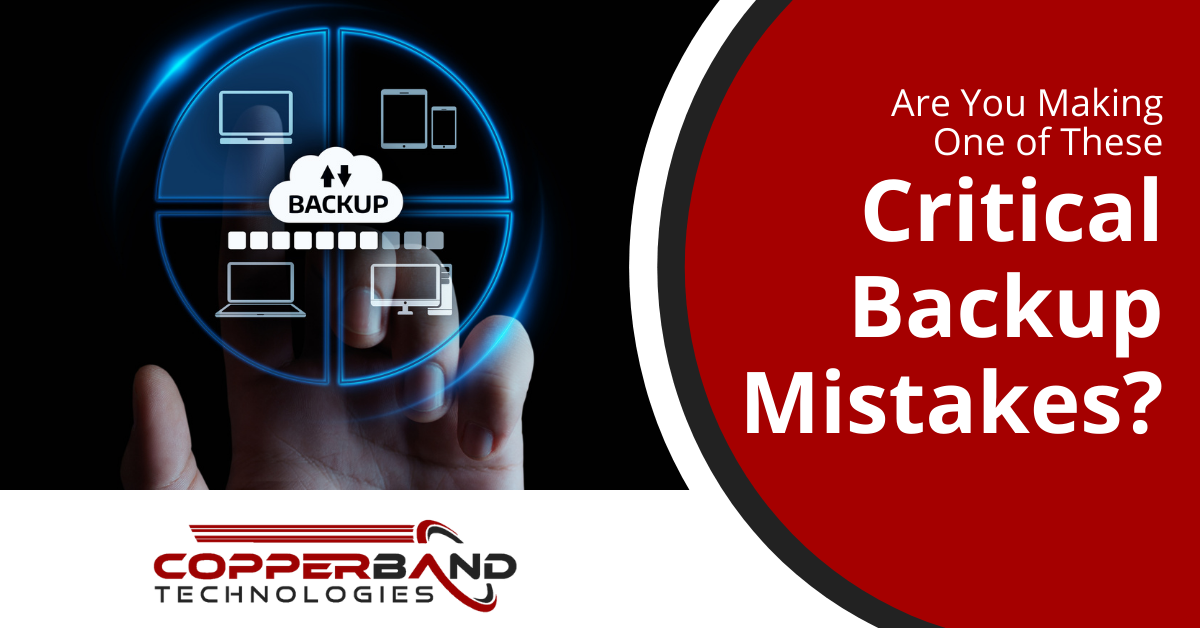Are You Making One of These Critical Backup Mistakes?

Backing up data should be easy, right? You just connect to a system and start a backup and then it takes care of the rest until you need it. Unfortunately, data backup and recovery is rarely that simple. Backups have problems, are set up improperly, are turned off by users, etc. The result can be devastating data loss. Common mistakes are why there is a 75% average failure rate for companies backing up all their data. What can one of those mistakes cost you? In the case of a ransomware attack, it can double your monetary losses. According to The State of Ransomware 2020, the average cost of remediating a ransomware attack is:
- Did not pay ransom: $732,520
- Paid ransom: $1,448,458
To avoid costly data loss due to ransomware, phishing scams, a hard drive crash, natural disaster, or other unexpected incident, you want to avoid these common data backup mistakes.
Backing Up on Old Media (USB Drives, CD’s)
While 15 years ago it might have been the norm to back up files on a CD or USB drive, that method is far outdated today. These types of backup media are easily lost or damaged. They can often have errors when trying to locate files, depending upon their age. If you want to back up onsite, then using a detachable hard drive or network-attached storage system (NAS) is much more reliable and can also take a full image backup rather than just copying files.
Never Checking a Backup (Until It’s Too Late!)
There is a reason that many MSP providers, like Copperband, offer managed backups. It’s because a backup is vital to business continuity and it’s important that it’s checked regularly to ensure it hasn’t hit any snags. Companies that just start backups once and expect smooth sailing from there forward, often find out in an emergency that something happened, and their last several weeks (or months) of data hasn’t been backed up. Problems that backups can run into include:
- Running out of space
- Not turning back on after a reboot
- Hitting a software or hardware glitch
- Being shut off by malware
Accidentally Turning Off a Backup
It’s not unusual for an employee to accidentally turn off a backup that their company has put in place on their workstation. They may be trying to speed up their computer and shutting off processes they don’t recognize in the Task Manager. Or they might not know what the program is and remove it from their Start settings, so the backup won’t start after a reboot. Not all users have the same tech savvy, which is another reason their workstation backups need to be monitored to ensure it’s running smoothly and capturing data.
Doing a File Backup Instead of Image Backup
There are two main ways of capturing information from a device:
- File Backup: Files and folders are copied
- Image Backup: The entire operating system (OS), settings, software, emails, files and folders are copied
The best and most complete method is to do a full image backup. This reduces your risk of losing important software in the case of a hard drive crash. It also offers the fastest recovery time. If you only have the files to restore to another workstation, then it’s going to take additional time restoring the OS settings, apps, email, etc. With an image back up, the entire OS environment and everything on the device are captured and can be restored to the same or a different device quickly.
Leaving Too Much Time Between Backups
You might think that a backup every Friday is fine for capturing your data, but there are a lot of files that can be created and received in a week. Companies that leave too much time between their backup intervals can find that they’ve lost quite a bit of information that has to be recreated. It’s best to have regular intervals that are at least every day, and possibly shorter than that. For example, some systems take backups of data every 15 minutes to capture any changes.
Not Backing Up Cloud Platform Data
Approximately 37% of SMBs and 47% of large enterprises have lost data in the cloud. Unfortunately, many businesses are assuming their cloud storage is a back up and aren’t backing up their data separately. This can lead to data loss and extended downtime should a cloud account suffer data loss from:
- Ransomware
- Accidental deletion
- Being overwritten
- Cloud provider outage
- Expired data retention date
Just because data has moved to the cloud in apps like Google Workspace and Microsoft 365, doesn’t mean that data no longer needs to be backed up separately. It’s vital to backup all your business data (on-premises, mobile, cloud).
Enjoy Monitored & Complete Backup & Recovery
Copperband Technologies offers monitored backup and recovery solutions for Southern Kentucky and Middle Tennessee businesses to ensure your data is always safe and quickly recoverable. Contact us today to schedule a consultation! Call 931.263.8000 or email us.






